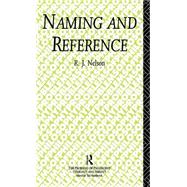Naming and Reference: The Link of Word to Object
, by Nelson,R.J.- ISBN: 9780415009393 | 0415009391
- Cover: Hardcover
- Copyright: 12/12/1992
The problem of reference is central to the fields of linguistics, cognitive science, and epistemology yet it remains largely unresolved.Naming and Referenceexplains the reference of lexical terms, with particular emphasis placed on proper names, demonstrative pronouns and personal pronouns. It examines such specific issues as: how to account for the reference of names that are empty or speculative, which abound in science and philosophy, and how to account forintentionalreference as in "he took Mary to be Jane." Naming andReferencebegins with a survey of the history of the subject within a philosophical and critical setting, from Locke, Brentano, Peirce, Frege, Russell, Strawson, Tarski, Carnap and Quine up to Kripke and Fodor. The rest of the book is devoted to an algorithmic theory of reference derived from Peirce's idea that signification is a three-way relationship involving a term, an object and an interpretant. Thetheory rounds out the causal notion of reference, while at the same time preserving Frege's distinction between sense and reference, and making a place for indexical terms. Through the use of various computer models, R. J. Nelson explores the meaning and reference of words to objects and the relationship of these phenomena to perception, belief and truth. The models used are parallel, connectionist computational models rather than the sequential models of mid-century artificial intelligence. The aim, in opposition to nativist and mental representation theories, is to account for the genesis of semantically interpretable symbols, not to assume them.






